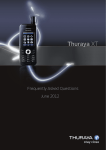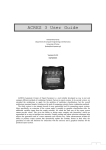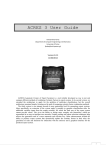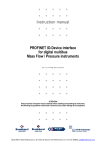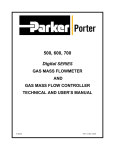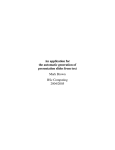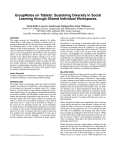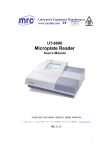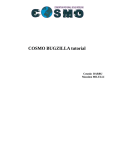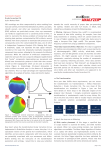Download Improving Domain-Specific Word Alignment with a General Bilingual
Transcript
Improving Domain-Specific Word Alignment with a
General Bilingual Corpus
WU Hua, WANG Haifeng
Toshiba (China) Research and Development Center
5/F., Tower W2, Oriental Plaza, No.1, East Chang An Ave., Dong Cheng District
Beijing, 100738, China
{wuhua, wanghaifeng}@rdc.toshiba.com.cn
Abstract. In conventional word alignment methods, some employ statistical
models or statistical measures, which need large-scale bilingual sentencealigned training corpora. Others employ dictionaries to guide alignment
selection. However, these methods achieve unsatisfactory alignment results
when performing word alignment on a small-scale domain-specific bilingual
corpus without terminological lexicons. This paper proposes an approach to
improve word alignment in a specific domain, in which only a small-scale
domain-specific corpus is available, by adapting the word alignment
information in the general domain to the specific domain. This approach first
trains two statistical word alignment models with the large-scale corpus in the
general domain and the small-scale corpus in the specific domain respectively,
and then improves the domain-specific word alignment with these two models.
Experimental results show a significant improvement in terms of both
alignment precision and recall, achieving a relative error rate reduction of
21.96% as compared with state-of-the-art technologies.
1
Introduction
Bilingual word alignment is first introduced as an intermediate result in statistical
machine translation (SMT) [3]. Besides being used in SMT, it is also used in
translation lexicon building [8], transfer rule learning [9], example-based machine
translation [13], translation memory systems [12], etc.
In previous alignment methods, some researchers modeled the alignments as
hidden parameters in a statistical translation model [3], [10] or directly modeled them
given the sentence pairs [4]. Some researchers use similarity and association measures
to build alignment links [1], [11], [14]. In addition, Wu [15] used a stochastic
inversion transduction grammar to simultaneously parse the sentence pairs to get the
word or phrase alignments. However, All of these methods require a large-scale
bilingual corpus for training. When the large-scale bilingual corpus is not available,
some researchers use existing dictionaries to improve word alignment [6]. However,
few works address the problem of domain-specific word alignment when neither the
large-scale domain-specific bilingual corpus nor the domain-specific translation
dictionary is available.
In this paper, we address the problem of word alignment in a specific domain, in
which only a small-scale corpus is available. In the domain-specific corpus, there are
two kinds of words. Some are general words, which are also frequently used in the
general domain. Others are domain-specific words, which only occur in the specific
domain. In general, it is not quite hard to obtain a large-scale general bilingual corpus
while the available domain-specific bilingual corpus is usually quite small. Thus, we
use the bilingual corpus in the general domain to improve word alignments for
general words and the bilingual corpus in the specific domain for domain-specific
words. In other words, we will adapt the word alignment information in the general
domain to the specific domain.
Although the adaptation technology is widely used for other tasks such as
language modeling, few literatures, to the best of our knowledge, directly address
word alignment adaptation. The work most closely related to ours is the statistical
translation adaptation described in [7]. Langlais used terminological lexicons to
improve the performance of a statistical translation engine, which is trained on a
general bilingual corpus and used to translate a manual for military snipers. The
experimental results showed that this adaptation method could reduce word error rate
on the translation task.
In this paper, we perform word alignment adaptation from the general domain to a
specific domain (in this study, a user manual for a medical system) with four steps. (1)
We train a word alignment model using a bilingual corpus in the general domain; (2)
We train another word alignment model using a small-scale bilingual corpus in the
specific domain; (3) We build two translation dictionaries according to the alignment
results in (1) and (2) respectively; (4) For each sentence pair in the specific domain,
we use the two models to get different word alignment results and improve the results
according to the translation dictionaries. Experimental results show that our approach
improves domain-specific word alignment in terms of both precision and recall,
achieving a 21.96% relative error rate reduction.
The remainder of the paper is organized as follows. Section 2 introduces the
statistical word alignment method and analyzes the problems existing in this method
for the domain-specific task. Section 3 describes our word alignment adaptation
algorithm. Section 4 describes the evaluation results. The last section concludes our
approach and presents the future work.
2
Statistical Word Alignment
In this section, we apply the IBM statistical word alignment models to our domainspecific corpus and analyze the alignment results. The tool used for statistical word
alignment is GIZA++ [10]. With this tool, we compare the word alignment results of
three methods. These methods use different corpora to train IBM word alignment
model 4. The method “G+S” directly combines the bilingual sentence pairs in the
general domain and in the specific domain as training data. The method “G” only uses
the bilingual sentence pairs in the general domain as training data. The method “S”
only uses the bilingual sentence pairs in the specific domain as training data.
2.1
Training and Testing Data
We have a sentence aligned English-Chinese bilingual corpus in the general domain,
which includes 320,000 bilingual sentence pairs, and a sentence aligned EnglishChinese bilingual corpus in the specific domain (a user manual for a medical system),
which includes 546 bilingual sentence pairs. From this domain-specific corpus, we
randomly select 180 pairs as testing data. The remained 366 pairs are used as domainspecific training data. 1
The Chinese sentences in both the training set and the testing set are automatically
segmented into words. Thus, there are two kinds of errors for word alignment: one is
the word segmentation error and the other is the alignment error. In Chinese, if a word
is incorrectly segmented, the alignment result is also incorrect. For example, for the
Chinese sentence “诊断床面的警告标签” (Warning label for the couch-top), our
system segments it into “诊断/床/面的/警告/标签”. The sequence “床面的” is
incorrectly segmented into “床/面的(couch/taxi)”, which should be “床面/的(couchtop/of)”. Thus, the segmentation errors in Chinese may change the word meaning,
which in turn cause alignment errors.
In order to exclude the effect of the segmentation errors on our alignment results,
we correct the segmentation errors in our testing set. The alignments in the testing set
are manually annotated, which includes 1,478 alignment links.
2.2
Overall Performance
There are several different evaluation methods for word alignment [2]. In our
evaluation, we use evaluation metrics similar to those in [10]. However, we do not
classify alignment links into sure links and possible links. We consider each
alignment(s, t ) as a sure link, where both s and t can be words or multi-word units.
If we use SG to represent the alignments identified by the proposed methods and
SC to denote the reference alignments, the methods to calculate the precision, recall,
and f-measure are shown in Equation (1), (2) and (3). According to the definition of
the alignment error rate (AER) in [10], AER can be calculated with Equation (4).
Thus, the higher the f-measure is, the lower the alignment error rate is.
precision =
recall =
fmeasure =
AER = 1 −
1
| SG ∩ SC |
| SG |
| SG ∩ SC |
| SC |
2* | SG ∩ SC |
| SG | + | SC |
2* | SG ∩ SC |
= 1 − fmeasure
| SG | + | SC |
Generally, a user manual only includes several hundred sentences.
(1)
(2)
(3)
(4)
With the above metrics, we evaluate the three methods on the testing set with
Chinese as the source language and English as the target language. The results are
shown in Table 1. It can be seen that although the method “G+S” achieves the best
results among others, it performs just a little better than the method “G”. This
indicates that adding the small-scale domain-specific training sentence pairs into the
general corpus doesn’t greatly improve the alignment performance.
Table 1. Statistical Word Alignment Results
Method
G+S
G
S
2.3
Precision
0.7140
0.7136
0.4486
Recall
0.6942
0.6847
0.4066
AER
0.2961
0.3014
0.5735
Result Analysis
We use A , B and C to represent the set of correct alignment links extracted by the
method “G+S”, the method “G” and the method “S”, respectively. From the
experiments, we get | A |= 1026 , | B |= 1012 and | C |= 601 and get two intersection
sets | D |=| A ∩ C |= 524 and | E |=| B ∩ C |= 516 . Thus, about 14% alignment links of
C are not covered by B . That is to say, although the size of the domain-specific
corpus is very small, it can produce word alignment links that are not covered by the
general corpus. These alignment links usually include domain-specific words.
Moreover, about 13% alignment links of C are not covered by A . This indicates that,
by combining the two corpora, the method “G+S” still cannot detect the domainspecific alignment links. At the same time, about 49% of alignment links in both A
and B are not covered by the set C .
For example, in the sentence pair in Figure 1, there is a domain-specific word
“multislice”. For this word, both the method “G+S” and “G” produce a wrong
alignment link (multislice, 扫描) while the method “S” produces a correct word
alignment link (multislice, 多扫描层). However, the general word alignment link
(refer to, 参见) is detected by both the method “G+S” and the method “G” but not
detected by the method “S”.
Fig. 1. Alignment Example
Based on the above analysis, it can be seen that it is not effective to directly
combine the bilingual corpus in the general domain and in the specific domain as
training data. However, the correct alignment links extracted by the method “G” and
those extracted by the method “S” are complementary to each other. Thus, we can
develop a method to improve the domain-specific word alignment based on the results
of both the method “G” and the method “S”.
Another kind of errors is about the multi-word alignment links 2 . The IBM
statistical word alignment model only allows one-to-one or more-to-one alignment
links. However, the domain-specific terms are usually aligned to more than one
Chinese word. Thus, the multi-word unit in the corpus cannot be correctly aligned
using this statistical model. For this case, we will use translation dictionaries as guides
to modify some alignment links and get multi-word alignments.
3
Word Alignment Adaptation
According to the result analysis in Section 2.3, we take two measures to improve the
word alignment results. One is to combine the word alignment results of both the
method “G” and the method “S”. The other is to use translation dictionaries.
3.1
Bi-directional Word Alignment
In statistical translation models [3], only one-to-one and more-to-one word alignment
links can be found. Thus, some multi-word units cannot be correctly aligned. In order
to deal with this problem, we perform translation in two directions (English to
Chinese, and Chinese to English) as described in [10]. The GIZA++ toolkit is used to
perform statistical word alignment.
For the general domain, we use SG1 and SG 2 to represent the alignment sets
obtained with English as the source language and Chinese as the target language or
vice versa. For alignment links in both sets, we use i for English words and j for
Chinese words.
SG1 = {( A j , j ) | A j = {a j }, a j ≥ 0}
(5)
SG 2 = {(i, Ai ) | Ai = {a i }, a i ≥ 0}
(6)
Where, a x ( x = i, j ) represents the index position of the source word aligned to the
target word in position x. For example, if a Chinese word in position j is connected to
an English word in position i, then a j = i . If a Chinese word in position j is connected
to English words in positions i1 and i 2 , then A j = {i1 , i 2 } .
Based on the two alignment sets, we obtain their intersection set, union set3 and
subtraction set.
2
Multi-word alignment links means one or more source words aligned to more than one target
word or vice versa.
3
In this paper, the union operation does not remove the replicated elements. For example, if set
one includes two elements {1, 2} and set two includes two elements {1, 3}, then the union of
these two sets becomes {1, 1, 2, 3}.
Intersection: SG = SG1 ∩ SG2
Union: PG = SG1 ∪ SG2
Subtraction: MG = PG − 2 * SG
Thus, the subtraction set contains two different alignment links for each English word.
For the specific domain, we use SF1 and SF2 to represent the word alignment sets
in the two directions. The symbols SF , PF and MF represents the intersection set,
union set and the subtraction set, respectively.
3.2
Translation Dictionary Acquisition
When we train the statistical word alignment model with the large-scale bilingual
corpus in the general domain, we can get two word alignment results for the training
data. By taking the intersection of the two word alignment results, we build a new
alignment set. The alignment links in this intersection set are extended by iteratively
adding word alignment links into it as described in [10].
Based on the extended alignment links, we build an English to Chinese
translation dictionary D1 with translation probabilities. In order to filter some noise
caused by the error alignment links, we only retain those translation pairs whose
translation probabilities are above a threshold δ 1 or co-occurring frequencies are
above a threshold δ 2 .
When we train the IBM statistical word alignment model with the small-scale
bilingual corpus in the specific domain, we build another translation dictionary D 2
with the same method as for the dictionary D1 . But we adopt a different filtering
strategy for the translation dictionary D 2 . We use log-likelihood ratio to estimate the
association strength of each translation pair because Dunning [5] proved that loglikelihood ratio performed very well on small-scale data. Thus, we get the translation
dictionary D 2 by keeping those entries whose log-likelihood ratio scores are greater
than a threshold δ 3 .
The corpus used to build D1 is the 320,000 sentence pairs in the general domain.
The corpus used to build D 2 is the 366 sentence pairs on the manual for a medical
system. By setting thresholds δ 1 = 0.1 , δ 2 = 5 and δ 3 = 50 , we get two translation
dictionaries, the statistics information of which is showed in Table 2.4
Table 2. Translation Dictionary Statistics
Unique English Words
Multi-Words
Average Chinese Translations
4
D1
57,380
18,870
2.1
D2
728
28
1.1
The thresholds are obtained to ensure the best compromise of alignment precision and recall
on the testing set.
In the translation dictionary D1 , the multi-words accounts for 32.89% of the total
words. In the translation dictionary D 2 , the number of multi-words is small because
the training data are very limited.
3.3
Word Alignment Improvement
With the statistical word alignment models and the translation dictionaries trained on
the corpora in the general domain and the specific domain, we describe the algorithm
to improve the domain-specific word alignment in this section.
Based on the bi-directional word alignment, we define SI as SI = SG ∩ SF and
UG as UG = PG ∪ PF − 4 * SI . The word alignment links in the set SI are very
reliable. Thus, we directly accept them as correct links and add them into the final
alignment set WA . In the set UG , there are two to four different alignment links for
each word. We first examine the dictionary D1 and then D 2 to see whether there is at
least one alignment link of this word included in these two dictionaries. If it is
successful, we add the link with the largest probability or the largest log-likelihood
ratio score to the final set WA . Otherwise, we use two heuristic rules to select
alignment links. The detailed algorithm is described in Figure 2.
Input: Alignment sets SI and UG
(1) For alignment links in SI , we directly add them into WA .
(2) For each English word i, we first find its alignment links in UG , and
then do the following:
a) If there are alignment links found in the translation dictionary D1 , we
add the link with the largest probability to WA .
b) Otherwise, if there are alignment links found in the translation
dictionary D 2 , we add the link with the largest log-likelihood ratio
score to WA .
c) If both a) and b) fail, but three links select the same target words for
the English word i, we add this link to WA .
d) Otherwise, if there are two different kinds of links for this word: one
target is a single word, and the other target is a multi-word unit and the
words in the multi-word unit have no link in WA , add this multi-word
alignment link to WA .
Output: Updated alignment set WA
Fig. 2. Word Alignment Adaptation Algorithm
Figure 3 lists four examples for word alignment adaptation. In example (1), the
phrase “based on” has two different alignment links: one is (based on, 基于) and the
other is (based, 基于). And in the translation dictionary D1 , the phrase “based on”
can be translated into “基于”. Thus, the link (based on, 基于) is finally selected
according to rule a) in Figure 2. In the same way, the link (contrast, 造影) in example
(2) is selected with the translation dictionary D 2 . The link (reconstructed, 再现) in
Example (3) is obtained because there are three alignment links selecting it. For the
English word “x-ray” in Example (4), we have two different links in UG . One is (xray, X) and the other is (x-ray, X 射线). And the single Chinese words “射” and “线”
have no alignment links in the set WA . According to the rule d), we select the link (xray, X 射线).
Fig. 3. Alignment Adaptation Example
4
Evaluation
In this section, we compare our methods with three other methods. The first method
“Gen+Spec” directly combines the corpus in the general domain and in the specific
domain as training data. The second method “Gen” only uses the corpus in the general
domain as training data. The third method “Spec” only uses the domain-specific
corpus as training data. With these training data, the three methods can get their own
translation dictionaries. However, each of them can only get one translation dictionary.
Thus, only one of the two steps a) and b) in Figure 2 can be applied to these methods.
All of these three methods first get bi-directional statistical word alignment using the
GIZA++ tool, and then use the trained translation dictionary to improve the statistical
word alignment results. The difference between these three methods and our method
is that, for each source word, our method provides four candidate alignment links
while the other three methods only provides two candidate alignment links. Thus, the
steps c) and d) in Figure 2 cannot be applied to these three methods.
The training data and the testing data are the same as described in Section 2.1.
With the evaluation metrics described in section 2.2, we get the alignment results
shown in Table 3. From the results, it can be seen that our approach performs the best
among others. Our method achieves a 21.96% relative error rate reduction as
compared with the method “Gen+Spec”. In addition, by comparing the results in
Table 3 and those in Table 1 in Section 2.2, we can see that the precision of word
alignment links is improved by using the translation dictionaries. Thus, introducing
translation dictionary results in alignment precision improving while combining the
alignment results of “Gen” and “Spec” results in alignment recall improving.
Table 3. Word Alignment Adaptation Results
Method
Ours
Gen+Spec
Gen
Spec
Precision
0.8363
0.8276
0.8668
0.8178
Recall
0.7673
0.6758
0.6428
0.4769
AER
0.1997
0.2559
0.2618
0.3974
Table 4. Multi-Word Alignment Results
Method
Ours
Gen+Spec
Gen
Spec
Precision
0.5665
0.4339
0.5882
0.5854
Recall
0.4083
0.096
0.083
0.100
AER
0.5254
0.8430
0.8541
0.8292
In the testing set, there are 240 multi-word alignment links. Most of the links
consist of domain-specific words. Table 4 shows the results for multi-word alignment.
Our method achieves much higher recall than the other three methods and achieves
comparable precision. This indicates that combining the alignment results created by
the “Gen” method and the “Spec” method increases the possibility of obtaining multiword alignment links. From the table, it can be also seen that the “Spec” method
performs better than both the “Gen” method and the “Gen+Spec” method on the
multi-word alignment. This indicates that the “Spec” method can catch domainspecific alignment links even when trained on the small-scale corpus. It also indicates
that by adding the domain-specific data into the general training data, the method
“Gen+Spec” cannot catch the domain-specific alignment links.
5
Conclusion and Future Work
This paper proposes an approach to improve domain-specific word alignment through
alignment adaptation. Our contribution is that, given a large-scale general bilingual
corpus and a small-scale domain-specific corpus, our approach improves the domainspecific word alignment results in terms of both precision and recall. In addition, with
the training data, two translation dictionaries are built to select or modify the word
alignment links and to further improve the alignment results. Experimental results
indicate that our approach achieves a precision of 83.63% and a recall of 76.73% for
word alignment on the manual of a medical system, resulting in a relative error rate
reduction of 21.96%. This indicates that our method significantly outperforms the
method only combining the general bilingual corpus and the domain-specific
bilingual corpus as training data.
Our future work includes two aspects. First, we will seek other adaptation
methods to further improve the domain-specific word alignment results. Second, we
will also use the alignment results to build terminological lexicons and to improve
translation quality and efficiency in machine translation systems.
References
1. Ahrenberg, L., Merkel, M., Andersson, M.: A Simple Hybrid Aligner for Generating
Lexical Correspondences in Parallel Tests. In Proc. of the 36th Annual Meeting of the
Association for Computational Linguistics and the 17th Int. Conf. on Computational
Linguistics (ACL/COLING-1998) 29-35
2. Ahrenberg, L., Merkel, M., Hein, A.S., Tiedemann, J.: Evaluation of Word Alignment
Systems. In Proc. of the Second Int. Conf. on Linguistic Resources and Evaluation
(LREC-2000) 1255-1261
3. Brown, P.F., Della Pietra, S., Della Pietra, V., Mercer, R.: The Mathematics of Statistical
Machine Translation: Parameter estimation. Computational Linguistics (1993), Vol. 19,
No. 2, 263-311
4. Cherry, C., Lin, D.K.: A Probability Model to Improve Word Alignment. In Proc. of the
41st Annual Meeting of the Association for Computational Linguistics (ACL-2003) 88-95
5. Dunning, T.: Accurate Methods for the Statistics of Surprise and Coincidence.
Computational Linguistics (1993), Vol. 19, No. 1, 61-74
6. Ker, S.J., Chang, J.S.: A Class-based Approach to Word Alignment. Computational
Linguistics (1997), Vol. 23, No. 2, 313-343
7. Langlais, P.: Improving a General-Purpose Statistical Translation Engine by
Terminological Lexicons. In Proc. of the 2nd Int. Workshop on Computational
Terminology (COMPUTERM-2002) 1-7
8. Melamed, D.: Automatic Construction of Clean Broad-Coverage Translation Lexicons. In
Proc. of the 2nd Conf. of the Association for Machine Translation in the Americas
(AMTA-1996) 125-134
9. Menezes, A., Richardson, S.D.: A Best-First Alignment Algorithm for Automatic
Extraction of Transfer Mappings from Bilingual Corpora. In Proc. of the ACL 2001
Workshop on Data-Driven Methods in Machine Translation (2001) 39-46
10.Och, F.J., Ney, H.: Improved Statistical Alignment Models. In Proc. of the 38th Annual
Meeting of the Association for Computational Linguistics (ACL-2000) 440-447
11.Smadja, F., McKeown, K.R., Hatzivassiloglou, V.: Translating Collocations for Bilingual
Lexicons: a Statistical Approach. Computational Linguistics (1996), Vol. 22, No. 1, 1-38
12.Simard, M., Langlais, P.: Sub-sentential Exploitation of Translation Memories. In Proc. of
MT Summit VIII (2001) 335-339
13.Somers, H.: Review Article: Example-Based Machine Translation. Machine Translation
(1999), Vol. 14, No. 2, 113-157
14.Tufis, D., Barbu, A.M.: Lexical Token Alignment: Experiments, Results and Application.
In Proc. of the Third Int. Conf. on Language Resources and Evaluation (LREC-2002) 458465
15.Wu, D.K.: Stochastic Inversion Transduction Grammars and Bilingual Parsing of Parallel
Corpora. Computational Linguistics (1997), Vol. 23, No. 3, 377-403











